More of AMD’s Brazos E-350 with the MSI X370 and Sony VAIO YB
by Jarred Walton & Dustin Sklavos on March 14, 2011 4:50 PM ESTAnd Then We Have the LCDs…
We can count the number of inexpensive netbooks/ultraportables with high quality displays that we’ve tested on one hand: ASUS 1001P, ASUS 1005HA, and if you want to stretch things a bit, the MacBook Pro 13. Everything else ranges from average to poor, and the MSI and Sony laptops we’re looking at today definitely come closer to “poor” than “average”. If you’ve never felt hampered by laptop display quality, it won’t matter, but if you’re hoping for something better just move along.
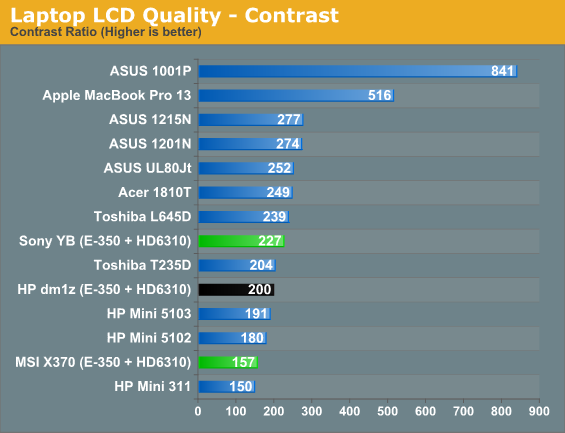
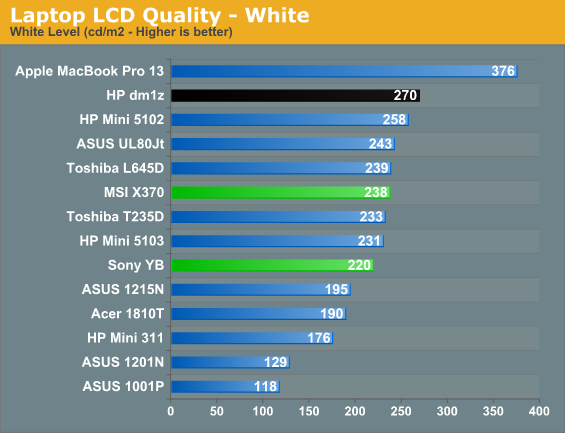


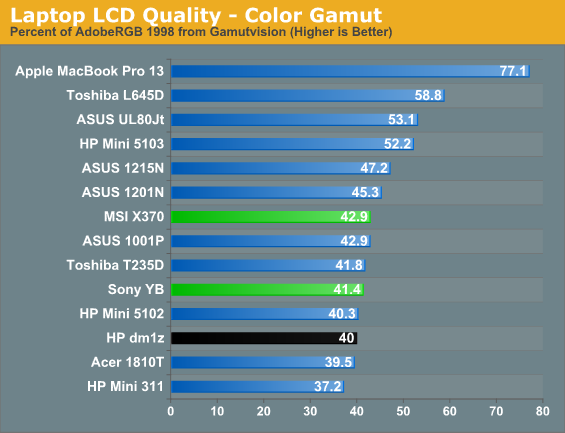
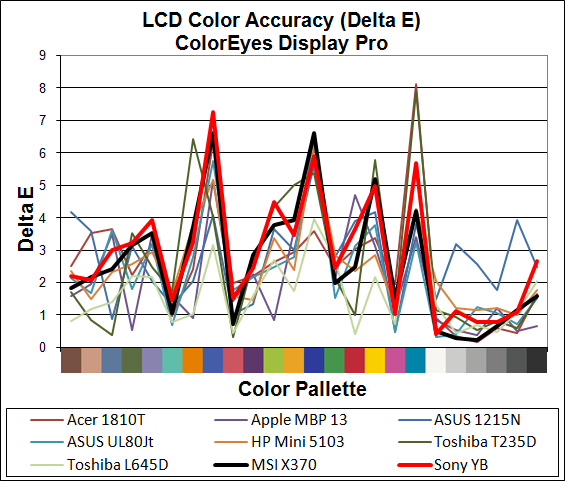
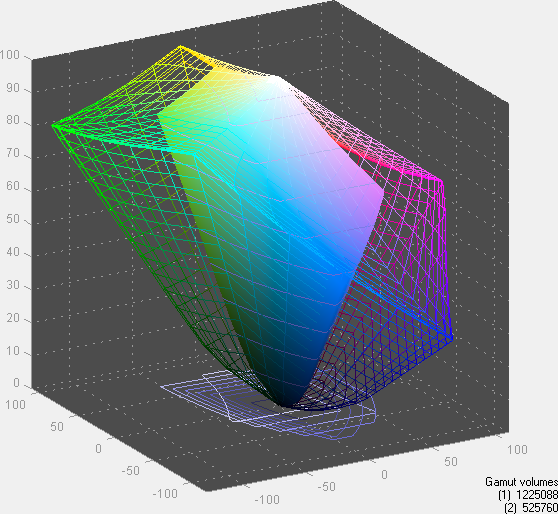
MSI X370 Gamut
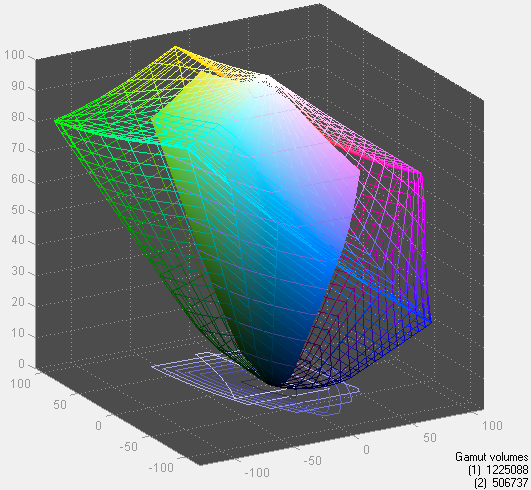
Sony VAIO YB Gamut
Sony actually does slightly better than the other two E-350 laptops in contrast ratio, but that’s about as good as it gets. HP wins for raw maximum brightness, still falling short of 300 nits (cd/m2); MSI is the second brightest and Sony is third, so despite the higher contrast it comes at the cost of outdoor usability. Given the portable nature of these laptops, we’d really like to see backlight intensity closer to the 400 nits posted by the MacBook Pro 13—yes, it will reduce battery life, but if you’re at a park (i.e. outdoors) that’s a fair tradeoff. Color gamut and accuracy are all poor across the three Brazos laptops: 40-43% gamut and 2.6 to 2.9 Delta E (after calibration!) will not win any fans around here. When you have companies like ASUS saying they’ll put IPS panels in $400 tablets, we’re not sure how much more it would cost to go from junk panels to something decent, but it can’t be more than $50. Please, make it happen.










43 Comments
View All Comments
lammers42 - Tuesday, March 15, 2011 - link
"Contrary to what you might expect, the 64Wh battery actually more than doubles battery life, suggesting the cells may be higher quality than in the 4-cell option."I've been telling everyone this for a long time . . . if you have the choice choose the higher capacity battery . . . they seem to use better performing cells.
It still doesn't explain why there is such a big difference between the different manufacturers in the quality of batteries of approximately the same capacity used which is evident from the relative battery life chart you show. As you get more Brazos systems to test it will be interesting to see if that will hold true.
Tasslehoff Burrfoot - Tuesday, March 15, 2011 - link
Brazos platforms should be under 350$ and at least under 400$. These manufacturers are getting carried away and they're even making fail noteboooks to top that off -_-All Zacate notebooks I've seen this far have either had disappointing specs (too little memory or too small resolution with too large display size or usin some lower processor model than the E-350) or horrible looks...
...or both.
Where is my all black matte ~12'' brazos lappie with sturdy chassis, 1440x900 resolution and an outstanding battery life? Why can't anybody get this simple thing right?
blacklist - Tuesday, March 15, 2011 - link
the closest approximation to what you want is probably the lenovo x120e. or just wait for the upcoming lenovo s205.silverblue - Wednesday, March 16, 2011 - link
3GB is more than enough for something this size, in my opinion. You're not going to be throwing massive workloads at the thing. I don't see why you'd want a 1440x900 resolution unless you're not gaming or the games aren't particularly tough on the hardware to begin with; what would you personally use a Brazos machine for, if I may ask?heraldo25 - Thursday, March 17, 2011 - link
I'm wondering how the E-350 and C-50 would fare against the first generation of Pentium M processors, are there any benchmarks like that?L. - Friday, March 18, 2011 - link
The first generation of pentium M processors were extremely bad iirc.If this beats a cheap C2D , it beats a pentium M. (or I don't remember which one is the pentium M, either way beating a cheap C2D is decent performance indeed).
But in all fairness, comparing the brazos to a pentium M is an insult to the brazos because the pentium M was a p3-P4 design mix, two designs that never handled multithreading in a decent fashion, and never got close to either AMD in that regard, or the subsequent C2D, which in most non-single-thread applications was much much faster.
So if you want comparisons, start with a decent chip, like a cheap C2D, or if you want to go back even more, barton athlons (yes, because those could do multithreading).
silverblue - Saturday, March 19, 2011 - link
I'd be more interested in comparing to Athlon 64s, both the single core variants and the X2s, considering AMD said Brazos should be close in performance to a similarly clocked Athlon 64 (90% I believe).JarredWalton - Saturday, March 19, 2011 - link
I suppose it depends on which Athlon 64 chip you're looking at. The K625 is actually clocked at 1.5GHz compared to 1.6GHz on the E-350. If we just focus on tasks that are pure CPU benchmarks:Cinebench 10 Single-Core: K625 is 47% faster
Cinebench 10 Multi-Core: K625 is 47% faster
x264 First Pass: K625 is 40% faster
x264 Second Pass: K625 is 29% faster
If they were aiming for 90% of the recent K10.5 Athlon II X2 chips, then, they didn't come anywhere near their goal. However, K10.5 is around 5-10% faster than K10, and K10 is probably another 15% faster than K8, so 90% of the original Athlon X2 parts is probably about right.
GTKevin - Tuesday, March 29, 2011 - link
Has anyone released a brazos platform laptop with a rotatable touchscreen so that it can be used as a tablet? I know the form factor will be bulky compared to a dedicated tablet, but for someone who is currently tabletless and likes to read ebooks in his free time, such a product would be very useful.aop - Tuesday, April 5, 2011 - link
Any hope on you guys taking apart a Fusion laptop like HP DM1z and make article about it's internals? It would be nice to see how the cooling is done and what kind of layout do the motherboards have etc.